Gravity Anomaly detected by using 4-way Doppler observation data from the RSTAR (OKINA) (RSAT)
-New finding in study on the Origin of Dichotomy for the Moon-
Kyushu University
National Astronomical Observatory of Japan
Japan Aerospace Exploration Agency (JAXA)
JAXA announced a new finding of a gravity anomaly for both the near side and far side of the Moon by using 4-way Doppler observation data from the RSTAR (OKINA) with the main orbiter, the KAGUYA.
Until now, the gravity anomaly of the far side of the Moon has not been understood well. The gravity anomaly, which was obscure before, has been clearly revealed through observations by the Kaguya mission. For instance, the gravity anomaly of a basin on the far side is found to be characterized by a negative anomaly in a ring like the Apollo basin. On the other hand, the gravity anomaly of the basin on the near side is uniformly positive over the region such as with the Mare Serenitatis. Thus, the clear difference in gravity anomaly on the near side and the far side has been newly discovered and this fact brings a different story about the structure of the underground and the history of the evolution of the far side and near side of the Moon.
The gravity anomaly map for many regions will be developed more precisely and show the difference of gravity anomaly between the near side and the far side by adding more observation data. The latest observation data by the Kaguya will play a key role to promote the study of the origin and the evolution of the Moon. In addition, highly accurate lunar gravity distribution data will be useful for future lunar explorers.
*Gravity anomaly: The lunar gravity field is not homogenous. Any region of the Moon with a higher than expected mass density will produce a gravity anomaly.
*Dichotomy of the Moon: Between the near side and the far side, clear asymmetry is called the "Dichotomy of the Moon" as in the thickness of the lunar crust and the distribution of the lunar Maria.
*RSAT/VRAD mission instrument team:
Kyushu University (RSAT Principle Investigator), NAOJ (VRAD: VLBI Satellite radio source Principle Investigator), Researchers from JAXA also participate as sub-PI or Co-I in the mission instrument team.
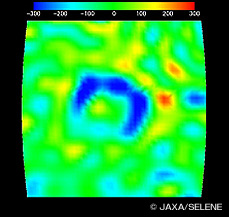 Gravity Anomaly Map by the KAGUYA |
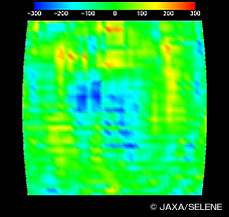 Gravity Anomaly Map in prior to the KAGUYA |
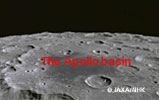 The Apollo basin(S36,W150) |
Current lunar gravity field models include large uncertainties on the far side of the Moon. For instance, the figure in the middle shows the current gravity distribution model for the Apollo basin by LP165P. The color of the figure shows strength of the gravity field in blue, green, yellow, and red, in that order. Red indicates a positive gravity anomaly related to either a topographic high or a dense material in the subsurface. In contrast, blue shows that a negative gravity anomaly related to a topographic low or less dense material. The gravity anomaly shown in the figure on the left hand side is processed by new data taken by the KAGUYA. The gravity anomaly in the Apollo basin is now identified as concentric rings of yellow, blue, and thin red from the center to outside.
*LP165P: Lunar gravity model developed by Konopliv et al.. incorporating tracking data from the Lunar Prospector spacecraft into a historical data set.
 Gravity Anomaly Map at the Apollo basin |
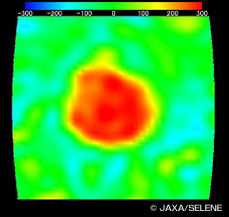 Gravity Anomaly Map at the Mare Serenitatis(N26,E19) |
 |
A new gravity anomaly map developed by the KAGUYA reveals that not only the Apollo basin, but many other basins on the far side of the Moon are characterized by a large negative gravity anomaly. Such a signature of far side gravity is distinguished from that on the near side. For example, the Mare Serenitatis, the representative basin on the near side, shows a strong positive (red color) gravity anomaly at the center of the basin (figure in the middle). The newly found difference of gravity anomaly on the near side and the far side gives us clues to important questions regarding the structure of the lunar interior and the formation of the far side and near side of the Moon. The gravity anomaly map will become more precise as more observation data is obtained by the KAGUYA. The latest observation data by the Kaguya will play a key role to promote a study of the origin and the evolution of the Moon. In addition, highly accurate lunar gravity distribution data will be used for future lunar explorations.
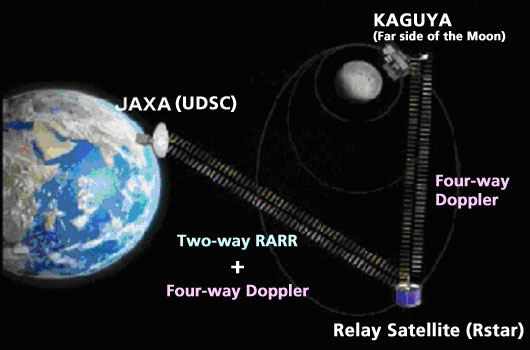 Four-way Doppler observation scheme |
A schematic figure showing the principle of the four-way Doppler measurements of the Main Orbiter (KAGUYA) by using a relay satellite (OKINA). The uplink radio wave from the Usuda Deep Space Center (UDSC) is relayed to the Main Orbiter via the relay satellite (OKINA), which is returned to the UDSC via relay satellite (OKINA) again. Then the Doppler frequency is measured at the UDSC.
Kyushu University http://www.kyushu-u.ac.jp/
National Astronomical Observatory of Japan http://www.miz.nao.ac.jp/rise.html
JAXA KAGUYA (SELENE) Project site http://www.kaguya.jaxa.jp/en/
|
|